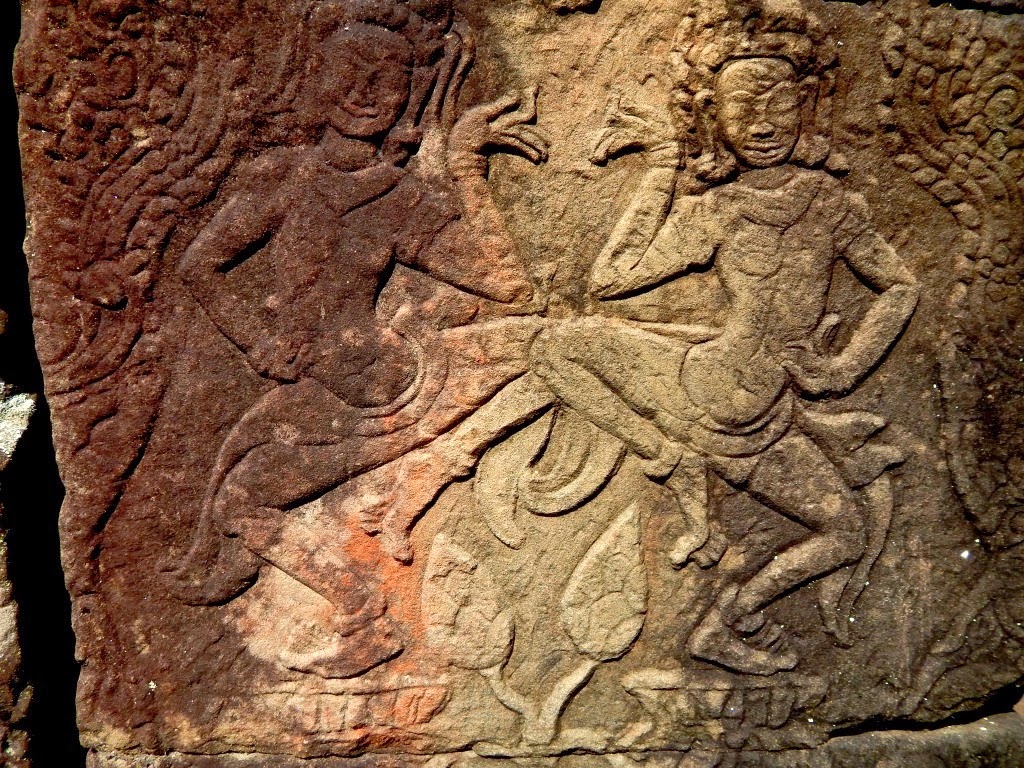19. Angkor
By Tuk-tuk.
After yesterday's exploration of the outskirts of the temple district on the motorcycle, I opted today for travel by tuk-tuk. My driver is Mr. Vanak, he speaks a little English, is a careful and considerate driver, and he is fast. This is a good combination.
We were out and about all morning until 2 p.m., and he will pick me up again at 4.30 p.m. to see the sunset at a temple to the East.
 |
| Moat around Angkor Wat early morning, one of many enormous water features, precisely master-planned. |
 |
| Mr. Vanak's tuk-tuk |
 |
| Me in the back. It is a bumpy ride, most of the time. |
Of course Angkor is a fantastic site. It is a UNESCO World Heritage location and one should have visited at least once in a lifetime. During days like that with cooler temperatures (mid 80s F, mid rel. humidity) it is very easy and enjoyable to visit.
 |
| Ta Keo |
The temples were closed until 1991 due to civil unrest. The Khmer Rouge held the main temple structures for their headquarters at times.
My last visit was during the rainy season, and I must say that, despite the wet weather and grueling humidity, the mosquitoes, and mud this is probably the best season to visit. Less tourists will come here, and the various forms of rain add a special mystique to this fantastic place. Having said that, it is very enjoyable and convenient to visit now.
Very briefly a super-sonic flight through Khmer history:
The Angkor period began at around 800 and approximately lasted until 1450. A succession of Khmer kings ruled the large country which was similarly highly developed as Thailand and Laos. All came to an end when the Thai's invaded and partially destroyed Angkor in the 15th century during their Sukhothai Period.
The temples in the middle of an (originally) inaccessible jungle remained "undiscovered" until 1860. The French naturalist Henri Mouhot is typically accredited with being the first foreigner to have discovered Angkor in the middle of the 19th century. But the claim that he is the discoverer of Angkor is unfounded. Many trades people from Spain and Portugal, missionaries from the Philippines (Spaniards) and last but not least, Mr. House, an American missionary and long-time resident to Siam saw and explored the ruins before Mouhot. The latter unfortunately contracted a severe fever and died here at age 35. His explorations and measurements were published posthumously. (Rooney, Dawn, Introduction to Angkor, ASIA Books)
Currently much major restoration work is going funded by foreign governments. So far I saw the work on Ta Keo being funded by the Chinese government and the restoration at Banteay Kdey being financed by India.
 |
| Work at Ta Keo |
Since years the theft of archaeological artifacts from the temples is a real danger. Since the border between Thailand and Cambodia is pretty porous statues and reliefs are stolen, transported to Bangkok, Thailand, from where they are sold throughout the world. The Angkor Conservancy Group in Siem Reap currently replaces original stone work with replicas at Angkor Thom temple to minimize the loss of irreplaceable art.
However, the complex is most threatened by the rapid growth of the jungle. Natures literally eats up the temples, and the monsoon rain does the rest. If there is ever a more telling example of the force of nature over man-made symbols of power it would be here at Angkor.
 |
| Ta Phrom |
 |
| Ta Phrom. The jungle takes over. |
 |
| Root hugging the stone. |
 |
| Very good watercolor artist. |
 |
| Dancing Apsara in Banteay Kdey, the "dance-hall temple" |
 |
| All columns are beautifully decorated with the dancing Apsara. |
 |
| Amazing masons. |
 |
| Apsara. |
Below is Sokhan, she is 21 years old, and sells Cambodia-made textiles and the famous checkered Cambodian scarf, called Krama, out of three wooden shacks on the grounds of Angkor, together with her older sister and her mother.
She worked in town in a restaurant once, but didn't like it at all. At the restaurant she earned about sixty dollars fixed income, since "tips" are uncommon here. She started working selling stuff when she was seven years old, and she knows every trick in the book. She alone now makes between $300 and $450 per month, depending on the season, minus $5 lease of the ground. Her family's house is only a stone throw away from the place where she has the bamboo shack. She works outside in nature, the sun and the rain, and she meets people from all over the world. She tells me that she likes it much better than working in the restaurant, having to deal with an angry owner lady, or working in a textile factory. She speaks English fluently, learned not in school, but in here little shop.
Young girls and boys are striking for a minimum salary of $160/month in Phnom Penh now, and are getting shot at, and killed by the military.




















No comments:
Post a Comment